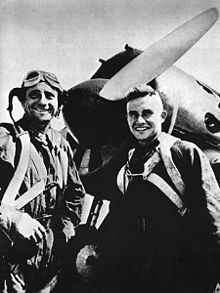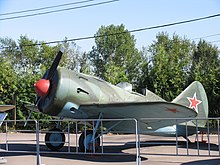Polikarpov I-16
It featured cutting-edge innovations such as retractable landing gear and a fully enclosed cockpit, and was optimized for speed with a short stubby fuselage, and a Wright R-1820 radial engine in a NACA cowling.
[citation needed] Full-scale work on the TsKB-12 prototype began in June 1933, and the aircraft was accepted into production on 22 November 1933, a month before it took to the air.
The cockpit was covered by a 40-centimetre-wide (16 in) canopy which featured an Aldis-type tubular gun sight which could slide back and forth on runners fitted with rubber bungee cords.
The armament consisted of a pair of 7.62×54mmR (0.30 in) ShKAS machine guns in the wings, mounted on the outboard side of the main gear and 900 rounds of ammunition.
However, TsAGI, with the help of the 3rd Design Brigade under the leadership of Pavel Sukhoi and Aleksandr Putylov, eventually convinced NII VVS that what was being proposed was not only feasible, but would enhance the aircraft's performance.
Initial government trials in February 1934 revealed very good maneuverability, but the aircraft did not tolerate abrupt control inputs.
Wind tunnel testing suggested that the TsKB-12, with its short tail, would enter an unrecoverable spin, but real-life trials were necessary to confirm this.
[9] The stories of vicious spin behavior of the I-16 perpetuated in modern literature is unfounded (perhaps extrapolated from Gee Bee experience).
The pioneering presence of a complex, triple-strut manually retracted main landing gear design was prone to jamming and required considerable strength from the pilot, who directly operated the rearmost strut's upper end, moved with a manually turned jackscrew running spanwise within the wing structure, to "slide" outwards and inwards on each side to respectively get the main gear retracted and extended, with the main strut (the forward-most of the trio) needing to shorten its length during its retraction to fit the mainwheel into the lower fuselage, performed by the middle-location strut's geometric arrangement and pivot locations.
The machine guns were fired via a cable and the required effort, coupled with sensitive controls, made precision aiming difficult.
The rear weight bias made the I-16 easy to handle on unprepared airfields because the aircraft was rather unlikely to flip over the nose even if the front wheels dug in.
But the Soviets suffered losses too; the group commander collided with an enemy aircraft and another I-16 pilot crash landed.
[20] The Polikarpovs immediately began dominating the enemy Heinkel He 51 and Arado Ar 68 biplanes[citation needed] and remained unchallenged until the introduction of the Messerschmitt Bf 109.
The arrival of the newest Bf 109Bs and the overwhelming numerical superiority of Nationalist fighters were the primary cause of the heavy I-15 and I-16 combat losses suffered throughout 1937.
Heavy machine gun bullets could sometimes penetrate the armored backrest, and fuel tanks occasionally caught fire in spite of being protected.
The hot Spanish summers required the addition of oil radiators, and dust adversely affected the life of the engines.
[23][24] A number Chinese aces flew the I-16; among them Lo Ying-Teh who in 1938 shot down Japanese unit leader Lt Ryohei Ushioda's A5M2 in his I-16 Type 5.
This model added a second set of 7.62 mm (0.30 in) ShKAS machine guns, armor behind the pilot, and had a slightly upgraded 560 kW (750 hp) M-25 engine.
In 1939, of the 500 I-16s[26] deployed to the fighting at Nomonhan, approximately 112 were lost during the battles of Khalkhin Gol, of which 88 were destroyed in aerial combat, primarily against the all-metal Nakajima Ki-27 Japanese fighters.
[28] Further attempts were made to upgrade the firepower of the aircraft using 20 mm (0.79 in) ShVAK cannons, making the I-16 one of the most heavily armed fighters of the period,[29] able to fire 28 rounds of ammunition in three seconds.
Ten Type 17 fighters were supplied to the Chinese Air Force where on 20 May 1940, they effectively shot down a C5M scout-attack plane and three G3M bombers during the Battle of Chongqing.
The addition of armor, radio, battery, and flaps during the aircraft's evolution exacerbated the rear weight distribution problems to the point where the aircraft required considerable forward pressure on the stick to maintain level flight and at the same time developed a tendency to enter uncontrolled dives.
When Operation Barbarossa erupted on 22 June 1941, 1,635 of 4,226 VVS aircraft were I-16s of all variants, fielded by 57 fighter regiments in frontier areas.
[33] The main assault delivered by the Luftwaffe's Luftflotte 2 (in support of Wehrmacht Army Group Centre) was directed against the Soviet Western Special Military District, that deployed 361 (424 according to other sources) I-16s.
[34] During the early phase of the campaign the I-16 bases were the main targets for the German aircraft and after 48 hours of combat, of the 1,635 Polikarpov monoplanes in service on 21 June 1941, only 937 were left.
[36] To stem the Luftwaffe aerial assault several I-16 pilots adopted the taran tactic and sacrificed their lives, ramming German aircraft.
Skilled Soviet pilots took advantage of the Polikarpov's superior horizontal maneuverability and liked it enough to resist the switch to more modern fighters.
The German aircraft, however, outclassed its Soviet opponent in service ceiling, rate of climb, acceleration and, crucially, in horizontal and diving speed, due to better aerodynamics and a more powerful engine.
[44][40][45] Commencing in 1993, New Zealand pilot and entrepreneur Sir Tim Wallis' Alpine Fighter Collection organised the restoration of six I-16s and three I-153s, found in Russia, to an airworthy condition by the Soviet Aeronautical Research Institute (Sibnia) in Novosibirsk.










